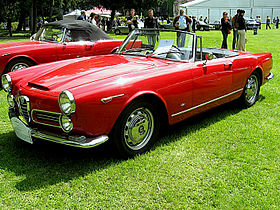Alfa Romeo 2600
| Alfa Romeo 2600 | |
|---|---|

Alfa Romeo 2600 Spider
|
|
| Overview | |
| Manufacturer | Alfa Romeo |
| Production |
1962–1968
|
| Assembly |
Portello, Milan, Italy East London, South Africa (2600 Berlina, 1963–1968 Car Distributors Assembly) |
| Designer |
Giorgetto Giugiaro at Bertone (Sprint) Ercole Spada at Zagato (SZ) Touring (Spider) Giovanni Michelotti for OSI (Berlina De Luxe) |
| Body and chassis | |
| Class | Executive car |
| Body style | 4-door Berlina (sedan) 2-door Spider (convertible) 2-door Sprint (coupe) |
| Layout | FR layout |
| Related | Alfa Romeo 2000 |
| Powertrain | |
| Engine | 2.6 L DOHC straight-6 |
| Transmission | 5-speed manual |
| Dimensions | |
| Wheelbase | Berlina/Sprint/Spider 2,720 mm (107.1 in)/2,580 mm (101.6 in)/2,500 mm (98.4 in) |
| Length | 4,700 mm (185.0 in)/4,580 mm (180.3 in)/4,500 mm (177.2 in) |
| Width | 1,700 mm (66.9 in)/1,706 mm (67.2 in)/1,690 mm (66.5 in) |
| Curb weight | 1,220–1,380 kg (2,690–3,042 lb) |
| Chronology | |
| Predecessor | Alfa Romeo 2000 |
| Successor | Alfa Romeo Alfa 6 |
1962–1968
11,346 produced:
The Alfa Romeo 2600 (Tipo 106) was Alfa Romeo´s six-cylinder flagship produced from 1961 to 1968. It was the successor to the Alfa Romeo 2000. It has become historically significant as the last Alfa Romeo to have been fitted with an inline six-cylinder engine with twin overhead camshafts. That had been the traditional Alfa Romeo engine configuration since the 1920s, but gave way to four-cylinder engines as the factory oriented its production towards more economical mass-produced car models starting in 1950.
The 2600 was introduced at the 1962 Geneva Motor Show, as a sedan with a factory-built body (2600 Berlina), a two-plus-two seater convertible with body by Carrozzeria Touring (2600 Spider), and a coupe with a body by Bertone (2600 Sprint). A convertible based on the Sprint coupe was shown by Bertone in 1963. It was also named 2600 Sprint, but did not enter production. The limited edition 2600 SZ (Sprint Zagato) with fastback coupe bodywork by Zagato, and the very limited-edition 2600 De Luxe with five-window sedan bodywork by OSI (Officine Stampaggi Industriali) were introduced three years later in 1965 at the Frankfurt Motor Show.
The Berlina, Spider and Sprint were based on the corresponding models in the 2000 range, and all three inherited the body styling of their predecessors with minor facelifts. The biggest change was the engine. A brand new all-alloy 2.6 liter engine with six cylinders in line and twin overhead camshafts replaced the earlier four-cylinder engine with its cast-iron block and alloy head which dated back to the 1900 range of 1950. Two carburettors were fitted to the Berlina engines, giving 130 bhp (97 kW). The Sprint and Spider engines had three twin-choke horizontal carburettors and developed 145 bhp (108 kW). The OSI De Luxe was available with either the two-carb or the three-carb setup. The Sprint Zagato had 165 bhp (123 kW) with the three-carb setup.
Total production for the Berlina was 2038 cars, the Sprint was 6999 cars, the Spider was 2255 cars, the 2600 De Luxe was 54 cars and the Sprint Zagato was 105 cars.
...
Wikipedia
